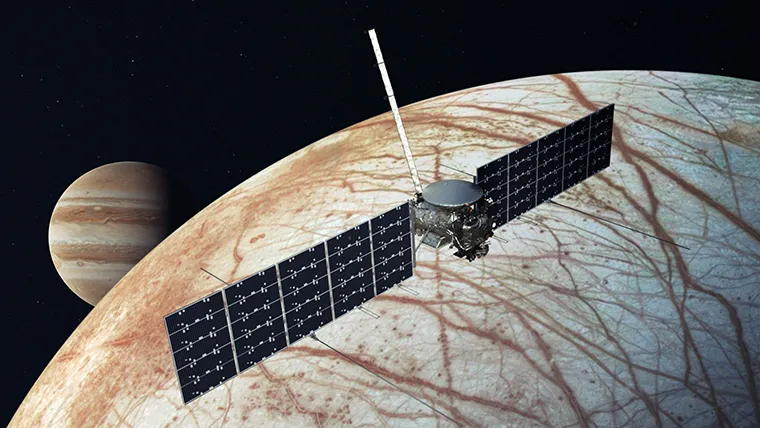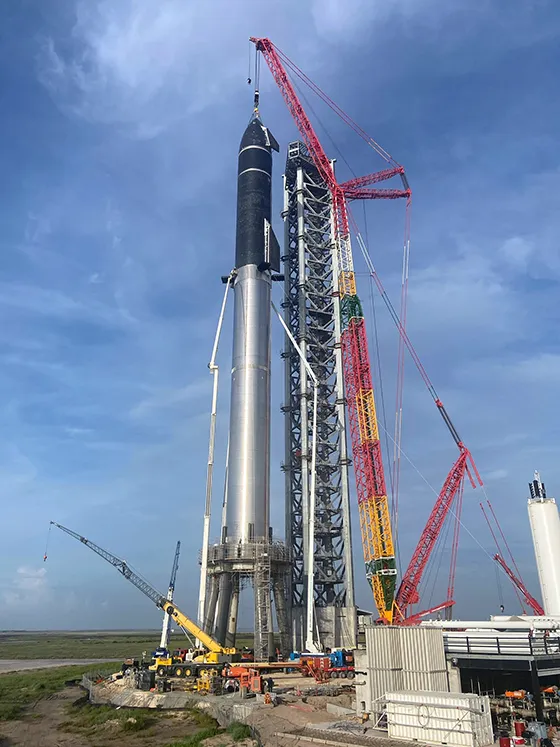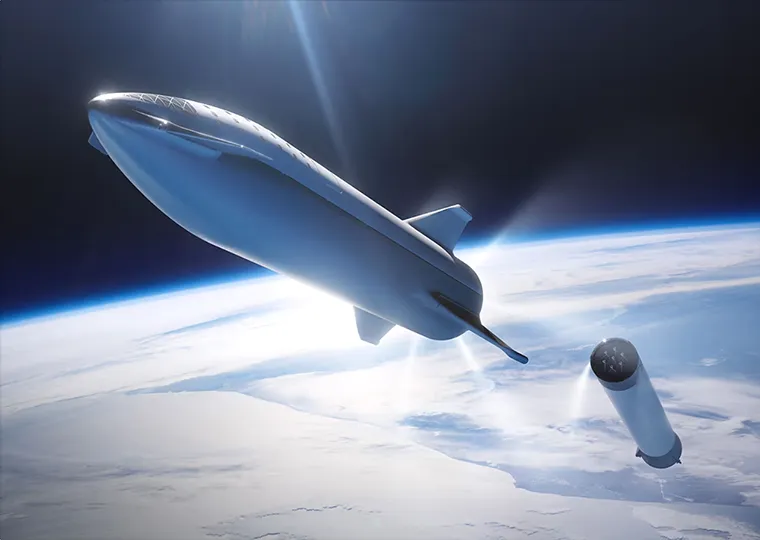The SLS: too expensive for exploration?
by Lifeboat Foundation Advisory Board member John Strickland.
The cost of each SLS mission could run into the billions, making the rocket unaffordable for any sort of regular use in exploration or other roles. Watch the full SLS launch video!
Introduction
UPDATE! This report was first published November 28, 2011 within one month of the SLS program announcement and has proven to be prophetic. Also note that the Falcon 9 had only flown twice at the time that this article was written and the Falcon Heavy and Starship were far in the future. John says, “I tend to be 10 to 20 years ahead of the bureaucrats in their thinking, but as I have no ‘position of authority’, my only power is that of persuasion by logic and argument.” (Images updated after report publication.)
Many members of the space community have spoken out strongly against NASA’s plans to develop the Space Launch System (SLS), disparagingly called the “Senate Launch System” by some and the “Franken-Rocket” by others. It should be noted for fairness that, to a large degree, this wrong design has been forced on NASA by a Congress bent on keeping current space jobs in their current locations. Most of the reasons currently debated for opposing the SLS are short-term, such as single-source contract legalities, but there are even more important long-term reasons. There are several reasons why I conclude that the SLS is unaffordable for its main intended purpose of landing crews and building bases on the Moon and Mars and that its continued development and implementation will probably be catastrophic for NASA and the human spaceflight program.
The Expensive SLS

The SLS would initially consist of an expendable core vehicle and two five-segment solid boosters that could orbit 70 tons. Refurbishing the solids after each use will cost about 80% of the cost of a new solid booster. A later version of the SLS is slated to use lighter, filament-wound solid boosters that would not be reused, making the entire vehicle expendable. The very large expendable core stage is based in part on the Space Shuttle’s expendable external tank, but this new stage would be a complete, monolithic, and very expensive rocket stage, which, along with all of its expensive engines, which would be destroyed after each launch as it impacts into the ocean. The upper stage (used only on the 130-ton version of the SLS) would use a variant of the Saturn 5’s upper stage J-2 engines and would usually be sent into solar orbit after a launch and also not re-used. If the SLS design logic is the reuse of “existing” shuttle parts, why is the SLS projected to cost so much more and take so much more time to develop than private alternatives?
The crucial fiscal issues for the SLS are the development costs, the cost per launch (not including the payload), and the annual operational costs. The high cost of each launch (refurbishment or replacement of the solid boosters, replacing the core stage and sometimes the upper stage, pad and launch operations, and the prorated costs of refurbishing and maintaining the old Apollo-era launch facilities to operate the system) will add up. They will ensure that, just as during the shuttle era, annual operational costs will be very high. These costs will continuously sap money from the NASA budget that is desperately needed for new technology that could actually advance our ability to operate in space.
One estimate of individual SLS launch costs (not including the payload) can be obtained from private launch cost projections, which are now about ten times lower than the current prices for government-sponsored launchers like the Delta 4 Heavy, which are actually increasing due to reduced launch rates. If the projected cost for the Falcon Heavy is about $850–1,000 per pound, or $100 million per 53-ton launch, for about four launches a year, then the cost per pound for an SLS payload would be about ten times higher at $8,500 to $10,000 per pound to low Earth orbit (LEO). This would equate to about $1.3 billion for the 70-ton payload version and $2.45 billion for the 130-ton version.
Projected launch costs for the proposed Falcon Super Heavy (150 tons to LEO) are about $300 million, giving cost per pound that are comparable to the Falcon Heavy or still about ten times cheaper per pound than existing costs or projected SLS costs. Some estimates for the SLS test launch costs are as much as 25 times more per pound ($25,000 per pound) than those for the Falcon Heavy. These estimates are based primarily on the development costs. If we include a typical government payload, the cost per mission (vehicle costs, operational launch costs and payload costs) approaches $5 billion or more per launch. It is thus probable that the cost of each SLS launch with payload will be much more than the cost of a shuttle launch, which recent calculations have shown to be about $1.5 billion apiece. The Shuttle did recover the “upper stage” (the Shuttle itself) with all of its expensive rocket engines.
In this discussion, the most important fiscal issue is annual operational costs. We assume that the annual NASA budget allocations will force an upper limit of these costs to an amount comparable to the shuttle’s average annual cost of about $5 billion a year. Some estimates place total costs of the SLS system as high as $63 billion through the year 2025, which assumes an average annual cost of $4.5 billion including both the developmental and operational periods. As a general rule, government program costs usually increase over time.
The high individual launch costs will prevent frequent launches of the SLS, and will especially limit the number of times it can be launched successively in a period of a year or two. One report shows an astonishingly slow projected launch rate of once a year, but based on a comparison of the annual budget available and the estimated individual launch cost, the rate is not surprising. This assumes that the payload (crew-carrying spacecraft, etc.) has a cost comparable to the booster rocket. The combined cost of booster and payload for a single launch would thus probably use up all of the manned space operations budget each and every year. These estimates compare poorly with the older estimates of a launch rate for the Ares 5 of twice a year, still totally inadequate for its intended purpose. Having very infrequent launches raises the cost of each launch, the prorated cost of each launch for development and for the ground equipment, and results in loss of training skills by the pad crews during the long intervals between launches.
Rapid Build-Up Requirements for Base Construction

“If we cannot afford to use the SLS frequently, we will not be able to use it for its intended purpose (beyond LEO exploration)” was proven true when the SLS later lost the Europa Clipper mission in 2021 to the Falcon Heavy.
If we cannot afford to use the SLS frequently, we will not be able to use it for its intended purpose (beyond LEO exploration). It will require maintaining a standing (launch vehicle) army that instead could be building the parts of a lunar or Mars base, for example. The SLS design also violates what should be a cardinal rule: design a transport system for the payloads that it is intended to carry and make sure that it is affordable for that purpose.
Why is the intended purpose—beyond Earth orbit (BEO) exploration—unaffordable with an SLS launcher? The two obvious kinds of exploration missions are brief visits to a target such as an asteroid, and creating a base on the Moon or Mars. It is true that a couple of missions, such as one to a near-Earth asteroid, could possibly be accomplished with a single launch. But the scientific benefits of such missions would run out rather quickly and developing an entire $30–40 billion BEO program just for visits to a couple of tiny asteroids is not justifiable. The next primary goals for the manned space program remain creating initial science and mining bases on the Moon and Mars, with early fuel production and crew safety as major rationales driving how the bases are created. Landing a crew on the Moon or Mars without establishing at least a minimal base or crew refuge at the landing site unnecessarily risks the lives of the entire crew.
The recent crisis with the International Space Station’s crew transport shows that we have not yet reached the ability to allow a complex human habitat and its equipment in space to remain unoccupied for a long period of time without risk of serious damage to or loss of the habitat. If you plan to build a surface base, it is clear that due to the extreme temperature variations on the surfaces of the Moon and Mars, you must accomplish the construction of an initial base build-up within a year or two at the most. This could be called a base buildup blitz. A series of launches within a short time to support such a rapid buildup might be called a launch campaign, similar to the rate of Apollo launches or faster.
To accomplish a rapid build-up for a lunar base with a launch campaign also means you must land enough equipment within about a year to ensure the safety of the crew from being stranded and to protect them from space radiation. This means either a secure refuge where they can stay until a rescue vehicle arrives, or a second (backup) crew vehicle that needs to be landed. It also means that the crew needs a secure energy supply (which needs to be one of the first items landed to keep the other equipment warm) and a crew habitat that has been dug in and covered with lunar regolith or lunar soil before the crew arrives. Each of these requirements means a large piece of equipment from 1 to 25 tons (such as a reactor, an earthmover, a habitat, etc.) needs to be landed, set up and connected together (or plugged in) with electric and electronic lines as part of a functioning base.
Much of the base equipment does need to be landed before the crew arrives, with initial set-up operations to be accomplished by the teleoperation of equipment from Earth or from lunar orbit. Due to the multi-second communications delay between Earth and Moon, some delicate telerobotic operations may be best performed from lunar orbit. With continuing improvements in telerobotics, such as the Dextre robot at the Space Station, robots will be able to do more and more of the work before the crew arrives.
Therefore a launch campaign supporting a base buildup blitz is a requirement to protect both the base equipment and the crew. The relationship between the base and the crew is also synergistic: as in any system (living or mechanical), the crew helps protect the base and its equipment and the base protects the crew. Thus the crew and the base and its equipment need each other.
It is hard to imagine being able to quickly set up such a base without a launch campaign of at least five HLV launches per year. To do this you will also need one or more cryogenic propellant depots in Earth orbit to assure that the propellant to support such a launch rate from LEO to the Moon or Mars is guaranteed to be available in LEO before the buildup begins. (Without the depots, the total cargo delivered to a base site for a given number of SLS launches would be cut about in half). The depots would also need to be launched by HLV boosters. Assuming a minimum of five SLS launches per year at $5 billion a launch, the total cost is $25 billion a year, far beyond NASA’s overall annual budget, let alone its human spaceflight budget. With a launch every two years, it would take a decade to provide the most minimal equipment for a surface base, and most of that would have been sitting there for many years and would thus likely be thermally damaged and unusable.
The result of the launch campaign requirement is the SLS is demonstrably too expensive to use to build a base anywhere, meaning we will be unable to afford to build either a lunar or Martian base with it. In addition, we would have just spent a huge amount of money to develop the SLS, and Congress will then be very unlikely to turn around and provide more money to build the “right” system.
Even if an SLS mission slot were used every two years to launch minimal expeditions to Mars, such missions would be very risky due to the minimal mass of the crew vehicles, which need a substantial mass of shielding (fuel and equipment) around them to protect the crew from space and solar radiation. There would also not be enough mass of equipment for redundancy or to build a robust base, so the boosters could only be used for minimal “Flags and Footprints” missions to Mars, with expendable (land and abandon) equipment, essentially duplicating the “Apollo on Geritol” type of missions envisioned for Constellation by Griffin. This raises the specter of a few such minimal Mars missions being conducted in the 2030 period, after which real scientific exploration of Mars by the US would probably be put off until the 2060’s due to financial exhaustion.
Other Uses for and Limitations of the SLS

“Private launchers currently under development will be far cheaper by the time the SLS was operational, so that it would be grossly uncompetitive by then” has proven true as the fully reusable Starship is coming online just as SLS prepares for its first launch.
How else could such an expensive SLS booster be used? It would be far too expensive to use for launching space-based solar power equipment, whose implementation depends totally on a drastic reduction in launch costs. Private launchers currently under development will be far cheaper by the time the SLS was operational, so that it would be grossly uncompetitive by then. Due to the lack of development money for payloads during development of the SLS booster, any large scientific payloads would need to wait until after 2021 for development starts. This would place the launch of such payloads, like large space telescopes or a large centrifuge facility for the ISS, well beyond 2025. The high launch costs would also guarantee that any scientific missions would also cost multiple billions. In addition, we need to ask a practical question, since these large launch systems are often used for over 30 years: do we really want the US to still be dependent on an expendable booster in 2030 or 2040?
In addition to the political impasse over booster development, the nature of the current NASA planning system results in a vicious circle, seemingly created by deliberately not including advanced technology components into future mission plans. The reasoning behind these decisions are that the components do not yet exist, but the result is that the badly needed components are never developed, since there is never a specific mission designated where they will be used.
Then when the mission is flown, its capabilities are greatly reduced due to the lack of the component. For example, NASA is currently budgeting money to develop cryogenic propellant depots in orbit, yet the depots are not included in or integrated into any plans for the BEO missions using the SLS. (This issue was the focus of a letter on September 27 to Administrator Bolden by Rep. Dana Rohrabacher.) Such delays and/or sapping of funds from technology programs for use by the SLS development by Congress allows mission planners to continue to exclude advanced technology solutions from future BEO mission plans.
Heavy Launch Vehicle (HLV) Alternatives

“Assuming that a privately-developed expendable HLV (such as a Falcon Super Heavy) could be launched for $300 million per flight, as SpaceX has already claimed” has proven prophetic as SpaceX has advanced so much while SLS was under development that the fully reusable Starship will actually only cost about $30 million per flight, or about 100 times less than the SLS.
What are the alternatives to the SLS? It is very obvious that the current, politically inspired plan shows a conspicuous lack of competition, in effect making the SLS funding a type of “earmark” for those specific areas of the country where the “legacy” space companies operate. The best direct alternative to this is an open HLV design competition similar to that for the propellant depots or for the crew transport system. Since SpaceX has already publically announced that they can provide a true HLV with a 150-ton to LEO payload for about $2.5 billion in about five years, this shows that there is at least one company that could save the taxpayers about $20–25 billion, or more, of development costs and have the rocket ready to fly in less than half the time the government-sponsored version would be.
Assuming that a privately-developed expendable HLV (such as a Falcon Super Heavy) could be launched for $300 million per flight, as SpaceX has already claimed, such a plan would allow the payloads for the booster to be developed by NASA (using other companies) while one private company was developing the booster itself. If some payload components are also developed privately, the cost would be more like $300 million per payload instead of $3 billion. Either way would ensure that payloads would exist when the boosters were ready to use and that the payload costs were spread over the years before the launch campaign. When the payloads are ready, five to ten HLV launches could then be accomplished in a single year or two for about $1.5–3 billion (for a total cost of $3–6 billion including payloads). This would allow a very rapid and efficient base buildup on either the Moon or Mars, and provide a large amount of safety and scientific equipment for the base crew to use.
Further and even more dramatic cost savings are possible. If an open competition were held to build an HLV whose first stage boosters would be recoverable from the very start, operational cost could be cut still further. Information that SpaceX will soon be testing a reusable Falcon 9 first stage (Grasshopper), as SpaceX announced in September, shows that a very serious effort to achieve first stage reusability is continuing. The method would reduce the payload significantly due to added booster mass, but in return would drastically reduce the cumulative launch cost. After an open competition, putting some government money up front into speeding the private development of a winning reusable HLV concept would save even more operational money and allow even more launches and larger expeditions. It is quite conceivable that launches of such an HLV would cost $100 million or even less. This would be about one-thirtieth of the projected launch cost of the expendable SLS.
Based on NASA timetables and statements made by SpaceX’s Elon Musk, it is clear that a BEO exploration program where the major hardware elements are built by private companies and then operated by NASA astronauts would occur far sooner than one where the major elements are built under close NASA supervision and rules. Such a program would have both lower development and lower operational costs. It is conceivable that such a program could take place even before NASA’s first scheduled lunar launch a decade from now, due to the greatly lowered costs. For example, assuming exploration launches with privately developed boosters and payloads, which each cost about $600 million, and launches with NASA-developed boosters and payloads which each cost about $6 billion, it is easy to calculate that you could launch 10 payloads with significantly greater total mass per payload with the private system for the same price as with a single NASA-style launch. With a recoverable booster the cost ratio would be 20 to 1 or more.
Based on current development cost estimates for the SLS including Orion of $29–38 billion, even the (expendable) Falcon Heavy could launch between 300 and 400 payloads of 53 tons each for the same amount of money, starting in about two years. This would amount to between 15,000 and 20,000 metric tons of equipment in LEO, enough to build up to six one-gigawatt space-based solar power plants or to build robust science bases both on the Moon and on Mars. With a recoverable version of the Falcon Heavy, the payload masses would at least double for the same price. With a system of propellant depots available in LEO, the dry payload mass capacity would double for the same rocket.
To be truly useful, a vehicle must be affordable for its intended purpose, and the SLS is not. In following its current course, NASA and the Congress are ignoring both fiscal and physical reality. In any contest between reality and human organizations bent on ignoring realities, guess who will lose.